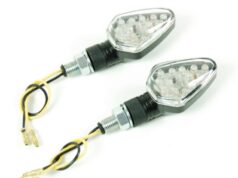
Lithium batteries promise large power reserves with low weight. We tested what modern power storage can do compared to a standard AGM battery.
At the very latest, anyone who has to replace their exhausted onboard battery is faced with the question: Which battery is the right one? In this article about batteries, we have presented in detail the types of batteries that are common in the market. But one essential question remained unanswered: What does the upgrade to a light but also expensive lithium RV battery (LiFePO4) do?
We wanted to know exactly and made the system comparison between an AGM and a lithium iron phosphate battery with a comparable capacity (AGM: 120 Ah, lithium: 110 Ah). Both batteries went into the race brand new, i.e., without any signs of age, for example, due to incipient sulphation. We equipped our long-term test mobile home with a complex measuring device to determine how much and for how long the various power storage devices release energy under experimental conditions.
How long a battery supplies electricity depends on the level of consumption. Therefore, it is impossible to say how many hours or days a motor homeowner can get by with the power storage unit. We activated various consumers at intervals over 12 hours to obtain comparable values. In this way, we simulated a realistic daily routine for each of the two batteries, one after the other. The batteries were then allowed to recover at night before the first consumer started again in the morning.
The test setup at a glance
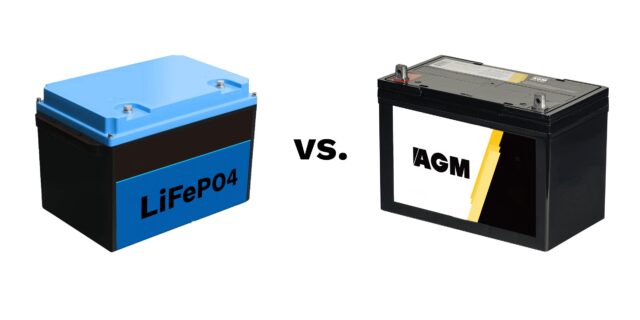
We recorded current and voltage over several days with a specially-made measuring device. The system’s heart is a box that uses a shunt to register all processes in the battery. We logged the data with a computer, presenting the results in tabular form. To avoid falsifying the measurement results, the laptop was connected separately to a power source outside the vehicle.
Test setup:
1) measurement box
2) Inverter 1700W
3) Charger 30A
4) Battery AGM/Lithium
5) data cable
6) Computer for data recording
The discharge of the batteries in comparison
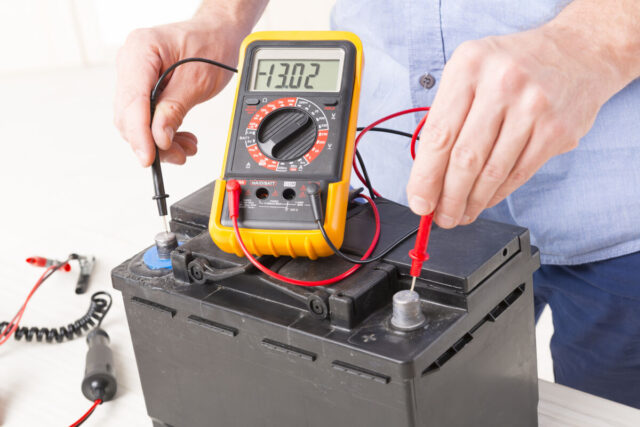
We could draw 88 Ah from the 120 ampere-hours of the AGM battery before the deep discharge protection kicked in after a good 35 hours. In this test procedure, 27 percent of the capacity turned out to be dead capital that cannot be used.
In practice, it should be even more because an AGM or gel battery should be recharged when 60 percent of its nominal capacity (here 72 Ah) has been used. Otherwise, the battery threatens to sulfate, which shortens its service life. For this reason, a lead-acid battery should never be stored partially discharged for a long period.
The lithium battery, on the other hand, is easier to maintain. It is not harmed by partially discharged idle periods or deep discharges and always delivers the same capacity regardless of the current. It is confirmed that 100 percent of the 110 Ah capacity can be used.
Accordingly, it lasted over 20 hours longer in our test. With the AGM battery, the deep discharge protection of the charger switched off the current drain at a voltage of 10.35 volts. With the lithium battery, on the other hand, the integrated control electronics prevent the deep discharge protection of the electrobloc from being activated.
The test also shows that the AGM battery can effectively deliver less capacity the greater the current drain. The voltage of the lead-acid battery drops significantly after the hair dryer is switched on, while it remains visibly more stable with the lithium battery. For the AGM power storage to be as efficient as possible, rest phases must be granted in which the voltage can recover somewhat.
Test: How long do the batteries provide energy?
For the test, we drew electricity in a controlled manner. A timer attached to the inverter activated a hair dryer with 1200 watts in the morning and the evening. This performance is comparable to a coffee maker. A second timer turned on a 40-watt light bulb four times a day, which corresponds to the power consumption of a television.
In addition, ceiling light with 0.3 amps was operated for 12 hours. While the voltage curve of the LiFePO4 battery only shows small steps, the voltage of the AGM battery drops significantly after a short time. Under the tested conditions, the lithium battery supplies the living area with 110-ampere hours for 2 days and 6 hours; with the AGM battery, the power supply lasts 1 day and 7 hours with 88-ampere hours.
Charging of the electricity storage in comparison
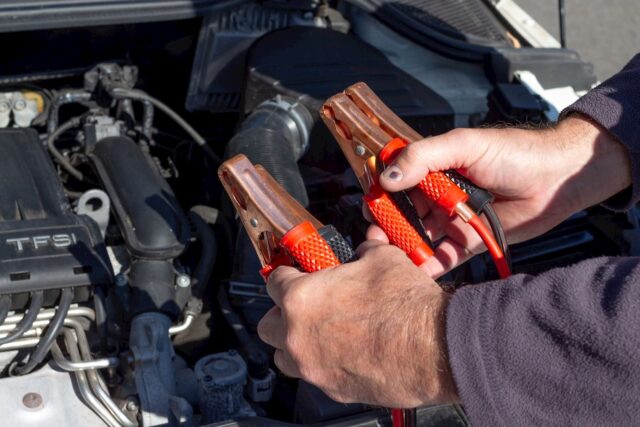
There are also differences when charging. The charging time depends primarily on the charger used. A powerful device with a maximum charging current of 30 amps was used in the test. But with the AGM battery, these are only exhausted for about three hours before the charging current is reduced due to the specific characteristic.
It takes twelve hours for 97-ampere hours to flow into the AGM battery. With the lithium battery, 112-ampere hours are recharged in just six hours since the maximum charging current of 30 amperes is around one hour long. To fully use the LiFePo4 battery’s quick charging capability, a suitable charger with the appropriate characteristic curve should be retrofitted in addition to the battery.
The lithium also benefits more than the AGM from a charging booster that feeds electricity into the battery while driving. Both batteries are initially charged at the same rate, but when the capacity approaches the maximum upper limit, the charger throttles the charging current of the AGM battery noticeably.
However, the advantages of the lithium battery also come at a high price: The Büttner lithium iron phosphate battery we tested costs around 4.5 times as much as the AGM battery with a similar capacity specification and dimensions. A longer service life alone does not justify the high price of the lithium battery. However, the lithium battery is a double win when looking at the power-to-weight ratio.
Compared to the AGM battery, which weighs more than 26 kilograms, you save 14.7 kilograms in weight and can use 22-ampere hours more at the same time. Investing in modern battery technology is only worthwhile, at least at the current prices, for motorhome owners who are often self-sufficient and want to use their battery capacity to the full in conjunction with an inverter.
If a high power requirement is to be met, travelers benefit particularly from the weight savings. To satisfy the hunger for power of an inverter and the 230-volt devices connected, it is best to connect two AGM batteries in parallel.
Usable 144 ampere-hours (as in the case of the test battery) would also mean a weight of more than 50 kilograms. Replacing the two AGM batteries with a LiFePO4 battery saves 39 kilograms with still generous, fully usable 110-ampere hours. If the power storage is charged regularly, the much cheaper AGM battery also serves its purpose. Even if you only operate 12-volt devices and not a hair dryer, kettle, etc., via an inverter, you will hardly ever fully use the amount of electricity available from conventional storage devices.
Test: How fast do the batteries charge?
The lithium battery was charged more energy than the AGM battery in half the time. The cause can be seen from the charging current curve. With the LiFePO4 battery, this is a full 30 amps for almost four hours. The AGM battery’s charging current drops steadily after just 2.5 hours.
After about nine hours, only low charging currents reach the batteries. At this point, the lithium battery is fully charged, while the AGM battery is still filled with additional ampere hours. Since losses occur during the charging process, a total of 97.4-ampere hours were charged, although only 88.62-ampere hours were drawn.
It depends on the use

Replacing an AGM RV battery is cheaper and usually easier. Suppose you want to retrofit a lithium battery. In that case, you must check whether the original charger is compatible with the new battery type because every battery type has its charging characteristic, which determines the charging current, end-of-charge voltage, and trickles charge. If the characteristic curve does not match the battery type, there is either a risk of overcharging or the battery will never be fully charged.
If you opt for a lithium battery, you should also note that there are different performance values beyond the capacity. The offered LiFePO4 models are designed for different strong discharge currents. The tested MT-Li 110 from Büttner Elektronik can withstand 200 amperes of discharge permanently, while other batteries of this type sometimes only allow 100 or fewer amperes.
Such batteries are unsuitable for operation with an inverter, from which a coffee capsule machine, for example, draws around 120 amps. However, an indication of the continuous discharge current is not always easy to find. This value is rarely noted in online shops or printed dealer catalogs. To be safe, you should ask the battery manufacturer for the technical data.
Sample calculation for possible daily consumption
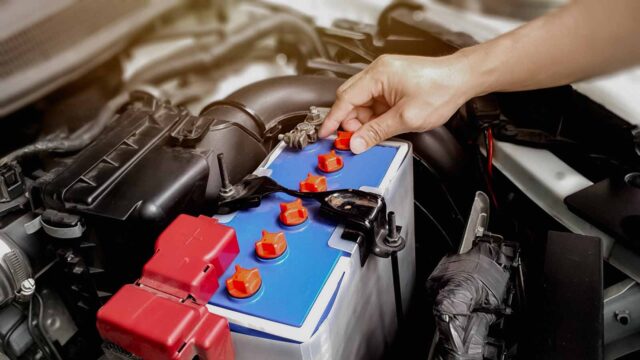
TV: 45 W x 4 h : 12 V= 15 Ah
Light: 16 W x 5.0 h : 12 V= 6.6 Ah
Water pump: 25 W x 0.5 h : 12 V = 1.0 Ah
Hair dryer: 1200 W x 10 min : 12 V= 17 Ah
Total: 39.6Ah
Advantages and disadvantages
AGM battery:
Tested battery MT AGM 120, price: 369 euros
+ Low price
+ Usually, no special charger is required
– High weight
– Capacity not fully usable
Lithium battery:
Tested battery: MT-Li 110, price: 1699 euros
+ Lightweight
+ More usable capacity
+ Shorter loading time
– Very high price
Conclusion
The AGM battery is cheaper and provides enough power for the average motorhome owner. Anyone with a frequent power connection and not forced to save the last kilo of weight will do well with the AGM battery.
With the lithium battery, the full capacity can be used, and you save weight. The high price justifies the purchase, especially for motorhome owners who are regularly self-sufficient and need a lot of electricity.






